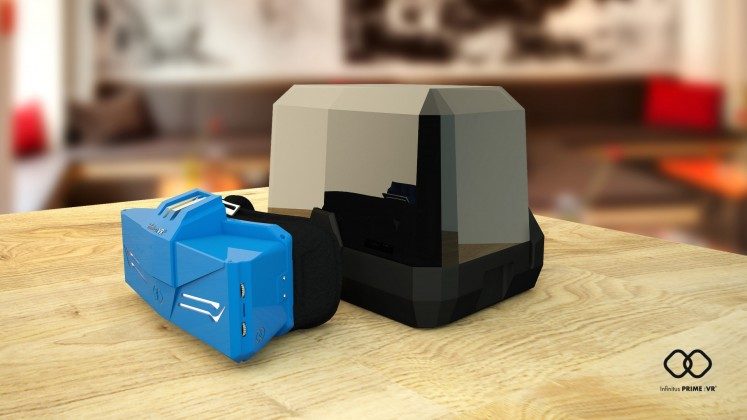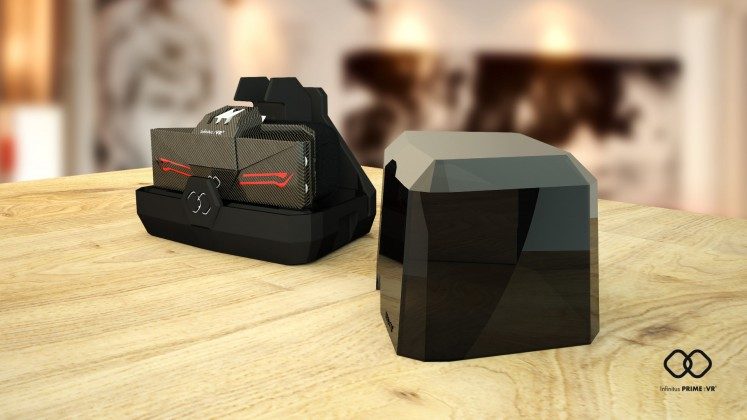The latest virtual reality headset to join the race is a headset not bothering to court the consumer market at at all. The Infinitus Prime tVR headset packs two 1440p displays and the Czech company behind the project are aiming the device squarely at industry applications.
The consumer VR ‘race’ has begun in earnest. With 2 major players, Oculus and Valve / HTC, now sending (or at least trying to) get VR headsets into people’s homes and Sony planning to unleash PlayStation VR in October, the retail market is already starting to feel well populated.
But what about the high-end commercial sector, where industrial budgets are potentially much higher with hardware requirements to match? A Czech company thinks its ready to tap into that market with its new product which is trying to push what is capable with currently available components to make what they describe as the “world’s most advanced and visually striking virtual reality headset” available. It’s called the Infinitus Prime tVR, and if you’re a long time VR enthusiast and that name reminds you of something, that feeling of deja vu you may be experiencing may be warranted.
Ignoring the marketing waffle, the specifications are certainly look impressive on paper. The Infinitus Prime packs dual 2560×1440 IPS LCD panels in what looks to be a canted arrangement. As a result, the new HMD boasts not only a pretty sizeable footprint, it also claims to deliver a pretty substantial 140 degrees horizontal field of view. Again, if this is starting to sound and look a little familiar, you may recall a French project called InfinitEye, another VR headset which sported similar design and specification goals and of course became StarVR, unveiled during the E3 in LA last year. Even the logo bears more than a passing resemblance to StarVR’s ancestor. The Starbreeze owned StarVR of course also boasts a 5k horizontal resolution, but ramps the FOV up to a staggering 210 degrees. With that in mind then, it’s probably no surprise then that StarVR doesn’t appear in the product comparison chart populated by the HTC Vive, Oculus Rift and GearVR – against which Infinitus Prime’s raw display numbers look impressive.
To be fair to Infinitus Global, the company behind the new device, it’s pretty difficult to build a headset in this sort of configuration and have it look any other way, but the naming and branding did raise some eyebrows on first inspection. Lets be clear here though, Infinitus Prime is not related to StarVR or Starbreeze, we’ve checked.
All that aside, Infinitus Global claims the Prime is the product of a 3-year development programme comprising 10 technology partners, 8 engineers, 5 software developers and 3 designers. If that’s the case, the company behind the project us certainly serious about VR. “Infinitus Global has launched more than a VR headset, we have launched an enterprise offering which has been designed to provide our customers with industry leading return on investment (ROI), low Total Cost of Ownership (TCO), high durability, a versatile engagement model, and a deep understanding of the VR marketplace and its technical breath[sic],” says Howard Thompson, CEO of Infinitus Global.
So where do Infinitus Global see this new device fitting in terms of market share? The company produced a handy info-graphic designed to illustrate just that (click to view larger version).
So it’s not crystal clear as to where the focus is, but there’s certainly a leaning towards the commercial sector and perhaps out of home marketing and entertainment venues.
We’re trying to dig up some more pricing and technical information on the Infinitus Prime tVR for you, as well as details on how developers will be supported, what state is the company’s SDK in and whether the new headset is compatible with existing devices in any way.




















